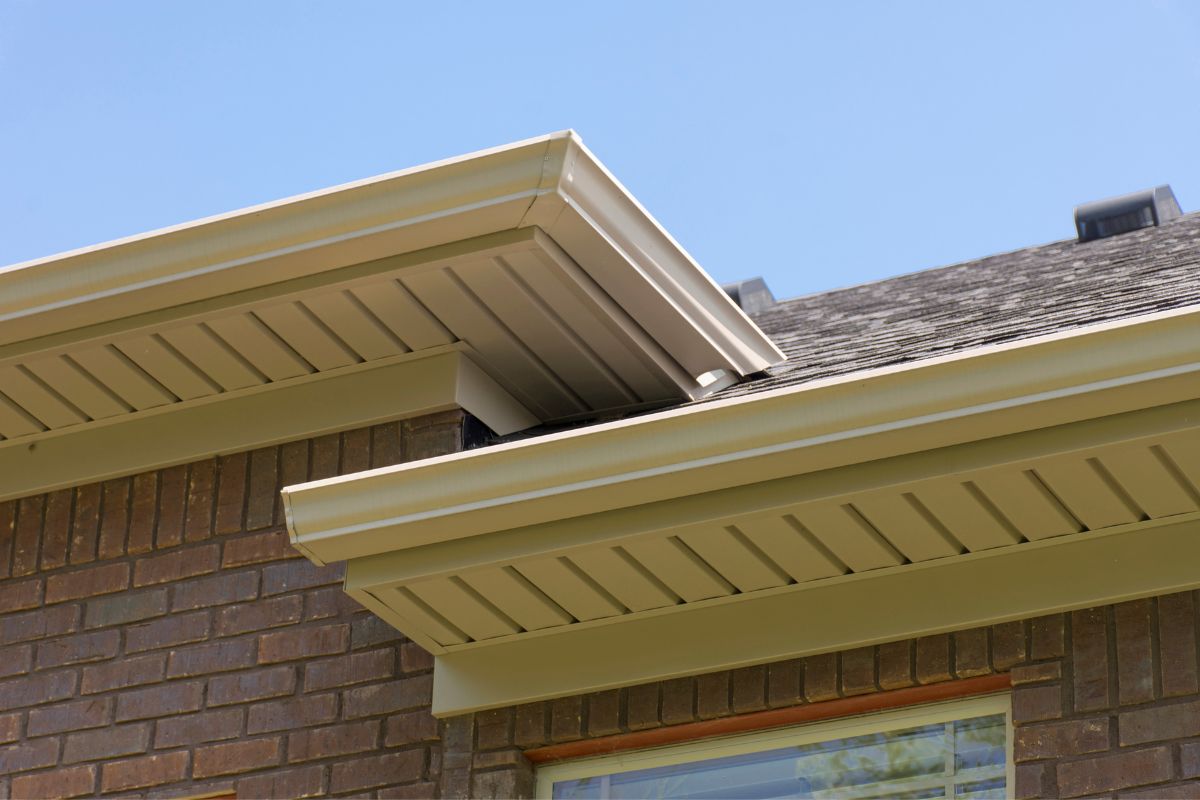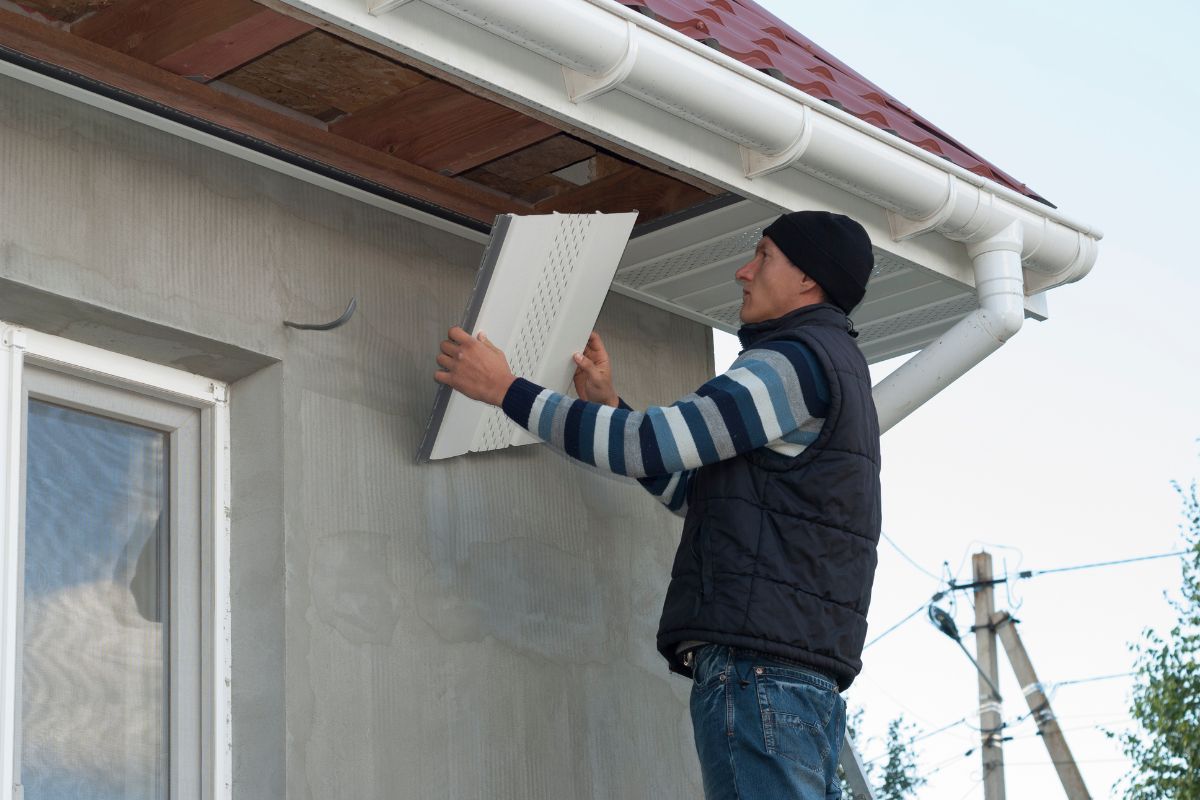There are many different aspects of roofing all with terms you may never have heard of. One of these is a soffit. But what is a soffit?

We look at the definition and purpose of this important element of your roof and why it is necessary.
We differentiate it from fascia and take a look at the different types and materials that soffits are made from.
What Is A Soffit?
A soffit is the underneath of your roof’s overhang. Sometimes the roof of a house will extend beyond the walls and this creates an overhang which has to be covered and protected. This is your soffit.
Soffits protect the underside of the roof from the weather, animal or insect invasion and provide a neat finish to this part of your roof.
It can be made from many different materials such as PVCu, aluminum, wood or fiber cement.
Different materials will suit homes in different climates.
Wood is not the best option for those who have a wet climate while aluminum in a hot environment will increase the heat in your attic and require greater use of your air conditioning.
Soffit is used in conjunction with fascia which is the vertical covering of your roof overhang. This typically holds your guttering too.
It’s important to understand the difference between soffit and fascia in order to keep them in the best condition.
What Is The Purpose Of A Soffit?
One of the main purposes of a soffit is to provide ventilation to your roof space while also protecting it against the elements.
Your attic space gets heated from both the inside and outside of the house.
Internally it is warmed by the heating system in your home, the use of hot water which adds humidity and the respiration of the people living in the house.
All of this adds up to warm air which rises up until it reaches your attic space.
Externally, your home gets heated by the sun beating down on the roof and walls, by warm winds and moist air.
Coupled with the warmth emanating from inside the house this heat accumulates in the roof space and if left unchecked will rapidly cause multiple problems.
This is where the soffit comes in. This horizontal covering allows airflow through the roof space to prevent a buildup of heat, moisture, and the formation of mold.
How Is It Different From Fascia?
A word that you will often hear in conjunction with soffit is fascia. The two are part of the structure in the area around your guttering.
Fascia is the vertical surface above the soffit that the gutters will typically be attached to.
This also plays an important role in protecting the roof space of your home and can similarly be made from PVCu, aluminum, wood or fiber cement.
As it is more exposed to the elements fascia needs to be carefully monitored for wear and decay.
It also supports the weight of your guttering which, if filled with leaves or debris can weigh heavily on the fascia and cause potential damage through overflowing gutters.
The soffit is more protected from the elements, but both are important aspects of the protection of the eaves area of your roof.
Is A Soffit Important For Your Home?

A soffit is important for covering the ends of the rafters that overhang the external wall of your house.
It serves more than an aesthetic purpose though and prevents water, insects and animals from entering into the roof space.
The most important job of a soffit however is to provide ventilation to the attic and roof space.
Without this ventilation the heat sources from inside and outside the house would cause damage to the interior of the roof space.
When your attic overheats it can cause damage to the shingles, which may break down more quickly.
It can also cause the formation of ice dams in the colder weather which in turn can lead to leaks.
Without adequate ventilation the heat in your attic can cause mold, mildew and more destructively, wood rot.
If your rafters begin to rot then the structural integrity of your roof may be compromised.
Types Of Soffit
There are three main styles of soffit, solid, vented and hollow. The type you have in your home may depend on the local climate, aesthetics or personal choice.
Solid
Solid soffits have a solid face and are very simple to install. They are a flat board which is used to cover the exposed underside of the roof overhang.
Vented
Vented soffits have pre-installed airflow holes to maximize the ventilation in your roof space.
This creates a balanced atmosphere in the attic which hinders a buildup of hot, moist air and the problems associated with that.
Hollow
Hollow soffit boards are a lightweight version made from PVCu and have an internal hollow structure which enables their light weight.
They have a solid face however, unlike a vented soffit which has airflow vents in the surface of the soffit.
Choosing A Soffit Material
There are four main materials that soffits are typically made from. PVCu, aluminum, wood and fiber cement.
PVCu
This is becoming the most popular material for soffits as it is lightweight, relatively cheap and resists weathering. PVCu soffits are also low maintenance and typically only require occasional cleaning.
Aluminum
Aluminum soffits are also lightweight, low maintenance and reasonably priced. But they can add to the buildup of heat in the roof space.
Wood
Wooden soffits are more expensive, and although aesthetically pleasing are high maintenance. If not cared for properly they can rot.
Fiber Cement
Fiber cement soffits are not the most popular but are often seen as vented soffits. They are water and insect resistant and low maintenance.
Final Thoughts
We hope this guide to what is a soffit has been informative and helpful. Next time you hear the word soffit you will know exactly what it is and how important it is as part of your roof.
- How To Drill Into Brick? - October 31, 2022
- How To Repair And Refinish Hardwood? - October 31, 2022
- Floetrol – What Is It? When To Use It: Complete Guide - October 31, 2022
